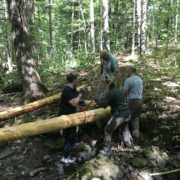Volunteer Monitoring 101 Lesson Five: Can I Copy Your Notes?
Several weeks ago I was the bad kid. I skipped class. Family duties called me away from the Upper Valley the same day that UVLT was hosting its Volunteer Conservation Easement Monitor Training. As a former Honor Role student this is extremely embarrassing to admit.
While I was gone, ten folks came to the UVLT office to kick off our annual training. They participated in a classroom session that lasted from 8:30 – 11am, after which they had lunch and carpooled to the field session at the Milton Frye Natural Area where they applied their newly learned skills from 11:30am – 2:30pm.
Did I mention that this was on a Saturday?!  And they covered a ton of material.
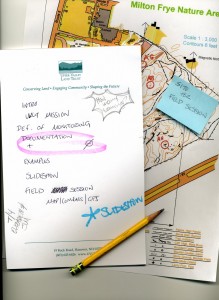 I reviewed the PowerPoint as well as the class syllabus upon my return; six main topics with multiple sub-categories followed by the field session. I was both impressed and overwhelmed! Key Facts that I noted from the presentation were:
I reviewed the PowerPoint as well as the class syllabus upon my return; six main topics with multiple sub-categories followed by the field session. I was both impressed and overwhelmed! Key Facts that I noted from the presentation were:
* Currently UVLT has 435 properties that are visited annually by staff or volunteers. This number grows every year.
UVLT’s Mission: The Upper Valley Land Trust helps people conserve land forever. We work with individuals and communities to protect the land that supports the ecological health and vitality of our region. UVLT stands committed to the stewardship of conserved lands for the benefit of present and future generations
Definition of Monitoring: “The regular and systematic collection of information about a protected property to identify changes over time and to ensure that it is being managed in accordance with the conservation easement.”
Â
These are things I try to keep in mind every time I am out in the field. I remind myself that in a way I am an ambassador between the land trust and the landowner or manager, I help keep the working relationship between the two strong. I also remind myself that I am out there to uphold UVLT’s mission and stewardship commitment with the goal of doing so in a way that is systematic and factually geared. Speaking of facts, one very important lesson that was emphasized in this training was the difference between documentation and judgment.
Good Documentation
- Weather conditions
- Natural changes
- Flora/fauna observations
- Land use/maintenance changes
- Objective description of observations
Leave Out
- Judgments about condition of property: such as quality of timber harvest practices, animal husbandry, structure condition
- Personal opinion
Example:
Good Documentation
I walked along the northern boundary; timber harvest was noted in the adjacent property that may have encroached upon the protected property.
Leave Out
I walked along the northern boundary and saw that the neighbor has carelessly cut trees down without any thought for the boundary line. I think that they clearly don’t care about the environment because where they cut looks very bad.
Even after all of this I was still feeling like I wasn’t getting the full picture of the experience. So, I asked some of my unsuspecting classmates if they’d let me “copy their notes†so-to-speak by answering a few questions I put together. Lucky me, they were willing! I’ve shared the responses of Elizabeth Traver, local blogger and bike rider (she rode to the training) and Jim Barker, newly appointed Chair of the Cornish Conservation Commission, below – thanks again you guys!
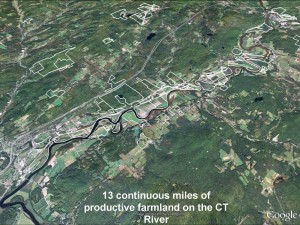
- What caught your interest about the volunteer monitor training; why did you choose to participate?
Elizabeth Traver (ET) – I love to walk in the woods anyway, I have been looking for ways to volunteer around the area, I figured I could learn something as well as learn more about places I can go for walks. Finally, I was looking for ways to meet some folks who might have similar interests.
 Jim Barker (JB) – I have done monitoring previously but recently became Chair of the Cornish Conservation Commission and thought I should improve my skills and knowledge.
- What did you learn in the classroom?
ET – A bunch of stuff about conservation easement, what it means, who might decide to use it; some of the legal ramifications. Also learned about what UVLT does to facilitate and monitor the easements
JB – Although I have an easement on my property I found the session on easements very helpful. Also the issue of building relationships with landowners and filling out the monitor’s form and what to put, or not, on it.
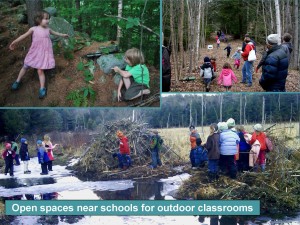
- What did you learn outdoors?
ET – I have never used a survey type compass, that was cool. Then getting to use the compass with the land maps to actually see how they work was cool! I also had not realized that my strides downhill are shorter than uphill–makes sense, just never actually measured them before.
JB – Learning what the length of my pace is and using pacing to find pins will be very helpful. Also was not aware of the 15 degrees between true and magnetic north.
- What did you like best?
ET – Being outside in the woods–see answer above
 JB – The orienteering
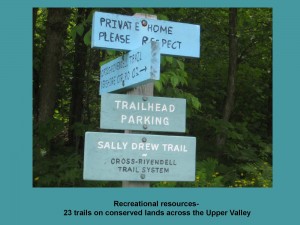
- What was the hardest part?
ET – Staying awake for the slide show-no, not really. No really hard part, except the biking back and forth
JB – Not eating more scones.
- Do you think you will monitor in the future?
ET – I plan to.
JB – Absolutely
- What is the big ‘take away’ lesson you’d share with the kid who “skipped class†(i.e. me!)?
ET – I think that learning about easements was really quite interesting, that there are so many easements in the area is awesome, that learning how to use the compasses and read land maps was cool. I also liked the idea that I can be part of the monitoring process!!
JB – Reading topography is very important as is shooting a line with a compass.
Their enthusiasm is contagious! It made me want to run out onto the land and get to work.
Now here I am a few weeks later reviewing all of the information before me.  I have learned some new things like measuring strides.  I have confirmed some old things like my duty as a monitor and the value of compass skills. But ultimately, I have come to appreciate that the biggest take away lesson for me is this: as a volunteer monitor I am part of a pretty neat community of people and what a valuable resource that is.
Anna Slack, UVLT Programs Coordinator, Monitor-in-Training

